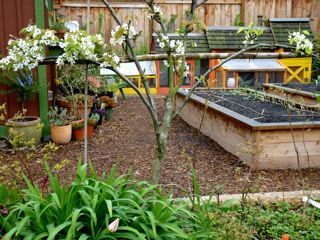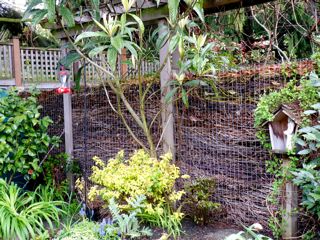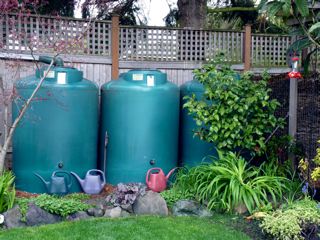I've always thought of sustainability, as it pertains to home gardens, as meaning not much more than good organic gardening practices. Feed the soil, put plants in places where they'll thrive naturally, eschew chemicals, pull weeds by hand... all those basic, common sense ways to garden in tune with earth's rhythms.
I've never understood why gardeners persist in spraying unhealthy plants -- get rid of the poor things, or move them to a spot that suits them better. Weeds? Practice birth control and pull the pests before they go to seed and multiply. Fertilizer? You don't need it... When you layer on manure and compost to filter down and improve the soil, the plants will take care of themselves...
But lately I've seen a couple of gardens that broadened my understanding of sustainability. Who would have imagined that the primeval good looks of native plants could not only hold their own with strong contemporary architecture, but enhance it? Environmental landscaping need not be merely serviceable or well-intentioned, as proved by a steep-slope garden north of Seattle. It'd be near impossible to weed safely or water effectively on this precipitous hillside; once established, natives will take care of themselves. The plantings are so richly textural and site-appropriate you don't even realize there's no lawn and few flowers. Birds and wildlife have been drawn back to the hillside, which is quickly regaining some of its wild character as multi-stemmed vine maples (Acer circinatum) and prickly Oregon grape fill in along the slopes. A little grove of Amelanchier grandiflora looks as if it might well have always stood right here next to this striking new contemporary home, especially when a flock of chickadees land to gorge themselves on the autumn fruit.
This is design with wisdom, rather than dogma; aesthetics haven't suffered despite the emphasis on biodiversity and restoration.
Then there's the very appealing little urban garden belonging to Jennifer Carlson. Her closed-loop sustainable garden in Seattle's Magnolia neighborhood is more working farm than city garden. The goal is to recycle all waste generated by plants and animals (chickens, rabbits and doves) right here in her own garden, and to capture and re-use rainwater for all the garden's irrigation needs.
Here are a few of Carlson's sustainable strategies:
Permeable Surfaces: Seattle, like many cities, has problems with water run-off. Carlson broke up a solid slab of concrete patio and replaced it with pavers separated by ribbons of stones to allow water to drain freely.
Soil: Carlson removed lawn to widen the beds, dug in compost and coffee grounds, and started planting. Because her plants got off to such a good start, and are frequently mulched, they require very little care to look their best.
Water Catchment: Carlson collects enough water (4,000 gallons) from half her 1,000 square-foot roof to water her entire garden, including lawn and vegetables. She attaches a hose or hooks up a sprinkler to the three dark green polypropylene cisterns, 625 gallons each, lined up against the back fence.
Chickens: The three Buff Orpingtons hens are moved around the garden in a bottomless "chicken tractor" pen, which protects and contains them while they turn over the soil and fertilize the lawn. The tractor is built of recycled cedar and hardware cloth; at night, the chickens return to the safety of their permanent hen house.
Appropriate Plantings: Every shrub, tree and perennial is vetted for drought-tolerance and durability. Her favorite, oft-repeated plants include flowering currant (Ribes sanguineum), Pacific waxleaf myrtle (Myrica californica), Viburnum davidii, Spirea 'Magic Carpet', yellow boxleaf honeysuckle (Lonicera nitida 'Baggesen's Gold'), the long-blooming Geranium 'Rozanne', the hardy autumn fern (Dryopteris erythrosora), variegated Japanese sedge (Carex oshimensis 'Evergold), and plenty of easy-care euphorbia and sedum.
Layering Edibles: A 15-foot-long espaliered fruit tree fence yields pears, apples and Italian prune plums. Every inch of land is productive; blueberries are layered beneath the little fruit trees, with a groundcover of strawberries shading the blueberry roots.
Composting Fence: Carlson's cedar and wire sandwich of a composting fence works as a privacy screen, attracts wrens and chickadees, and cuts down on the amount of woody waste she needs to haul off property because most pruned branches can be cut to fit into the fence. Over time the green waste breaks down to feed the plants growing all around it.
Creature Contributions: Even the creatures that live in this busy garden are multi-taskers. Take the fluffy angora rabbit Mocha. His alfalfa hay bedding and droppings are composted to fertilize the garden. Other colorful coops and hutches hold three Buff Orpington hens cooing doves and a quail, all of which contribute eggs to eat and manure and bedding to improve the soil.
Take a look at Jennifer's raised beds, colorful chicken coop, espaliered fruit trees, composting and water catchment tanks... and be inspired:


